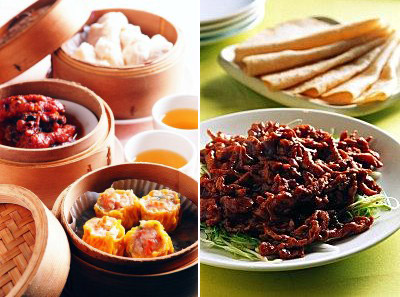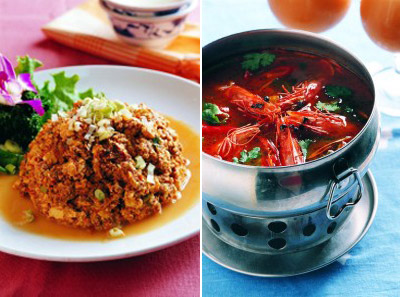This overview of Chinese food was written by Denis McKenna in late September 2008 after visiting Shanghai and other parts of China with son John & wife, Yan who live is this huge city.
Chinese food in China can be a big surprise to the visiting Westerner. Food in China as eaten by the locals is very different from the notion Westerners gain from their encounters with Chinese food in their home countries. Chinese food arrives at the table as individual, specific dishes, is very often made from ingredients which are unrecognisable to the Westerner (or if recognised, may not be considered edible fare at all) and is prepared & dispensed via hugely varying (by Western values) hygiene standards.

During my time here in Shanghai I have been at tables in good restaurants where deep-fried sparrow, boiled pigs snout, and even a freshly sliced, still-twitching fish in a basket have been served for my consumption. No thanks. Chicken & duck claws are regularly on menus. Also no thanks. And…can you imagine the tonnage of food and the logistics required to harvest, transport, store, cook and present fresh food for more than 1.3 billion people three times a day or more? Such a massive operation is difficult to get one’s head around.
My take on food in China is that it seems to have cultural, social and medicinal significance. Food in China has been important in religious, government, and health policies from ancient times. (Not like in most western countries, where food can be basic fuel, an annoying necessity on the run or at home, a habit, alone, or a pleasant lazy meeting with friends, and has no position in official business except as a public health issue.)
In China food is life, and life must be in balance. So it is important the food Chinese people eat should also be in balance. (Many Western people can have difficulty with this concept.) Particular dishes establish a cultural & regional identity, and can make or break a social reputation. Food for most Chinese is a routine custom carried out three or more times a day, pretty much at regular times, nearly always with care of thought and selection. In China food must be fresh and fast (although specific cold dishes which have been standing a while are acceptable and “buffet” style outlets are beginning to become popular – some offering over 300 separate platters). Fresh & fast applies to almost all food vendors…of sea & water creatures especially, of mini-snacks, maxi-snacks, main meals, bakeries (of which there are zillions), fruit & veggies, even western meals.
A twenty minute wait for some dishes can be tolerated, but rarely longer. Fast, fresh food is the big appeal of the footpath handcarts, and meals served from the front doors of buildings on the street where preparation and delivery immediately happens in front of the customer and is eaten with minutes of ordering. Wherever you may be in a town or city in China it is unlikely you will ever be more than 50 metres from some food for sale. “Food streets” are a feature in many cities, where no wheeled traffic is allowed (except for the ubiquitous scooters & bikes etc!) and the food outlets are packed side by side for up to a kilometre.
One of the reasons we see few Chinese eating in western restaurants in western countries is not because they don’t like the food (they generally do) but because they do not have the patience to put up with the seemingly endless wait for the food to arrive. This has the flow-on effect of preventing Chinese diners from becoming accustomed to, and enjoying at a more leisurely pace, good Western food and thereby helping adjustment to the local western culture.

Food in China is regularly used as gifts for friends, family, work colleagues - even employers etc. In fact is seems to be a traditional (and pressure) requirement to return from a holiday or visit to another province, to bring some local food back as gifts. Many cities, especially those which can lay claim to unique local produce, have specialty shops where the regional or area food is on sale specifically packaged for gifts and traveling.
Food for important Chinese occasions and ceremonies like a wedding, birthday, new job/promotion, birth, traditional holiday, senior’s milestone etc. is a pressure task for the planners and requires considerable thought and discussion to present the right dishes, with the right textures and colours and in the right order. Get this wrong and the host may lose respect and standing within the family or group. Chinese discuss food, what it was, where it was from, how it was cooked, how it was served, what the service & ambience of the restaurant was like, just as “British” folks discuss the weather – but with a great deal more intensity! Significant regional differences, the amazing diversity of harvested ingredients and the variety of cooking methods across this huge country makes “Chinese food” difficult to describe as one consistent cuisine. “Chinese food” in Western countries is most often a limited selection of Cantonese dishes modified for western tastes.
To a Western eye, food outlets in China can provoke feelings ranging from disgust to delight. John & I have eaten a plate of delicious dumpling soup sitting on small plastic stools on the footpath where the food is prepared, cooked and served, and all the waste and leftover food is dumped into the gutter beside us. (An army of civic cleaners with brooms, shovels and special carts work almost 24/7 to pick up and take away the considerable debris from these countless little footpath “restaurants”.) Food handcarts, operated mostly by individuals, appear at almost every corner or open space and carry their own storage and fuel. The range of their food offerings has to be seen to be believed and the cooking ingenuity of the cart owner can make a great show. (The civic authorities in Shanghai are planning to clean up this low-end food business in time for the Expo in 2010, but you can be sure the locals will resist to the bitter end.)
By contrast, many food premises are progressive to the extent that food is prepared in hygienic kitchens by cooks with clean whites and face masks, and all money is handled separately by a cashier. Many “coffee shops” and similar, are so Western in their presentation and food that once inside, a Westerner could be forgiven for thinking he/she was at home.
In the major cities there are vast restaurants in which patrons may lose their bearings and the waiting staff use electronic ordering systems to connect with the kitchen. Some restaurants can be the pinnacle of elegance, with service, food selection and décor beyond anything that might experience in home towns. The “take-away” / “take home” market is huge. Polystyrene boxes are provided at almost every food venue and many folk can be seen walking in the streets carrying their breakfast, lunch, or dinner. It is quite an accepted custom for diners in good restaurants to ask for a box to take away any uneaten food.
Supermarkets are well equipped to supply the “cook-at-home” market with enormous ranges of everything any Chinese household may need, including many varieties of live fish, frogs, eels & sea snakes, turtles, crabs, shrimps, shell-fish of all kinds and sizes, and many cuts of fresh meat products. Eggs come from many sources and are sold in a number of colours. A wide selection of frozen meat & fish is also available. Supermarkets also cater well for the take-home market by offering many of the prepared foods available in restaurants.

Three key points.。。
1 - A basic aspect in more formal Chinese dining is…ordering. Few restaurants have English menus (those which do are often written in amusing Chinglish) and the selection of dishes should conform to “balance” in the total meal. Very few Westerners are able to order Chinese dishes to the satisfaction of Chinese diners. If a truly authentic Chinese meal is required, whether it be breakfast, lunch or dinner, then leave it to your Chinese host to order the dishes on offer.
But…ordering protocol is absolutely nowhere to be found at any of the multitude of “cheap & cheerful” fast food eateries in China.
2 - To a large extent Chinese animal food products are served complete with bone & gristle intact, including much of their large variety of seafood – fish, prawns, crab etc. Most Chinese are very “teeth dexterous” (can they be said to have denterity, or donterity?), can quickly and easily separate the good from the bad in the mouth, then discard the waste to the plate or table by what looks like spitting to a Westerner. Do not be offended by this; it is perfectly normal system of efficient nutrition extraction. A Westerner could try this, but you may need some practice before you get much food from this style of eating.
3 - If you are ever invited by your Chinese host to dine in their home or in a fine restaurant, try to remember that finishing your plate or eating the last of an item on a dish is NOT the thing to do. For “British-brought-up” Westerners, finishing your plate is polite manners and indicates to your host that you have fully enjoyed your meal. By contrast, finishing your plate in a Chinese meal situation is not polite and indicates you have not been satisfied and are still hungry. This can lead to embarrassment on both sides; the host scrambling to find more food for you, and you being seriously persuaded to eat more food than you can manage. Lesson: - At the end of your meal, always leave some food on your plate and in the serving dishes.
Overall Summary.
Whether sitting down, or standing, eating real Chinese food can be a daily succession of amazing, surprising, enlightening and particularly fun experiences. Perhaps not everything will be to your liking but do not be afraid to try; you will be rewarded with tastes and textures never imagined in food in the Western world.
John, has produced a foreigner-friendly bi-lingual pocket menu which he gives away to encourage tourists and travelers coming to China to experience and enjoy local Chinese food. There is no dog, cat or other “peculiar” foods on this menu, and all should be recognizable to the foreign traveler, and with a good selection of vegetable dishes.
Travel the Real China.com
Warning:The use of any news and articles published on eChinacities.com without written permission from eChinacities.com constitutes copyright infringement, and legal action can be taken.
All comments are subject to moderation by eChinacities.com staff. Because we wish to encourage healthy and productive dialogue we ask that all comments remain polite, free of profanity or name calling, and relevant to the original post and subsequent discussion. Comments will not be deleted because of the viewpoints they express, only if the mode of expression itself is inappropriate.
Please login to add a comment. Click here to login immediately.